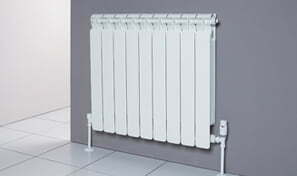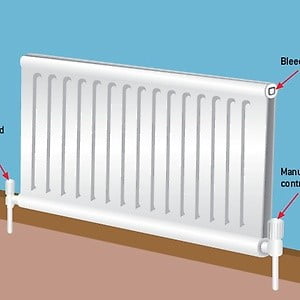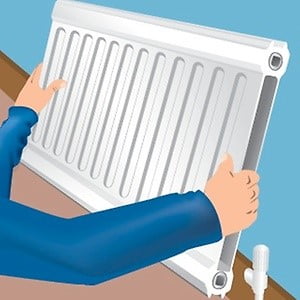
FARAL Aluminium radiators are the most efficient radiators available and usually provide the same heat output for half the size of a steel panel radiator.
1. Turning off the water supply
- Your first step is to turn off the central heating and allow the water in the system to cool.
- At one end of the radiator is a manual lock shield valve, turn this to the off position
- You may have a thermostatic valve or manual valve at the other end, make sure it is also turned off and not just to the frost setting which will pass water.

2. Draining the old radiator
- Place a bowl or bucket under the manual control valve.
- Grip the body of the valve with one adjustable wrench. Hold it steady while you use another wrench to gently loosen the nut that connects the radiator valve to the radiator (fig. 2).
- Now you need to vent the radiator of air to break the vacuum inside and allow the water to flow out of the control valve. Do this by opening the bleed valve at the top with a radiator key (fig. 3).
- Hold a towel under the bleed valve to catch any drips.
- Keep draining the water out of the control valve end of the radiator until the flow stops.

3. Removing the old radiator
- Once the radiator is drained, loosen and undo the nut that connects each of the valves to the adaptor in the radiator.
- You may have to gently push the central heating pipes and valves outwards to free the connections. But be careful not to bend them (fig. 5).
- Lift the radiator upwards to remove it from the wall brackets. You’ll probably need help for this (fig. 5). Close the bleed valve with the radiator key (fig. 4).
- There’ll usually be some dirty water left in the bottom of your radiator or towel rail, so tilt it to one side and drain this into a bucket.
- Place the radiator on old towels or sheets.
4. Replacing your large steel radiator with a smaller high efficiency FARAL Aluminium radiator
- When you replace your old radiator with a smaller FARAL Aluminium radiator, the pipework will not connect up exactly.
- You will need to drain your central heating system so the pipes directly under the floor or out of the wall can be replaced or adjusted to fit the pipe centres of the new FARAL radiator.
- You will need to be an experienced plumber to drain down and safely work on your heating system.
5. Stopping corrosion in your heating system
- When air and water meet in any radiator they cause corrosion and this reduces the efficiency and lifespan of your radiators, boilers pumps and other associated components.
- Deal with this by adding anti-corrosion fluid such as FERNOX or Sentinel to the system (as usual, carefully read the manufacturer’s instructions).
- With an open vent system (one with an expansion tank or cistern), put anti-corrosion fluid into the cistern.
- For sealed systems, you can buy a cartridge of inhibitor that’s injected through the radiator’s air bleed valve.



